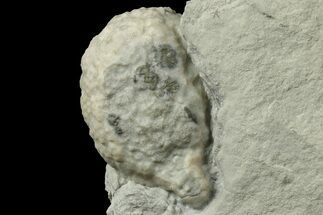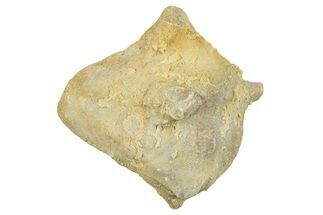This Specimen has been sold.
Silurian Cystoid and Crinoid Fossil Associaiton - New York
This 5.5" wide block of shale contains a beautifully preserved fossil cystoid (Callocystites jewetti), a partial crinoid (Crinobrachiatus brachiatus, brachiopods, and bryozoa, collected from the Rochester Shale of New York. These were very unique finds because cystoids are almost always (99% of the time) found without arms or stems. The layer these cystoids originally came from had been exhausted for over a decade, but recent excavations in the past few years exposed additional material.
This crinoid can be found at the base of the cystoid stem, though like most of the crinoids found of this species, it's fairly disarticulated.
Comes with a display stand.
This crinoid can be found at the base of the cystoid stem, though like most of the crinoids found of this species, it's fairly disarticulated.
Comes with a display stand.
Cystoids are extinct echinoderms similar to crinoids. They consist of a stalk, theca (body), and brachials (feeding arms). Most lived fixed to the seafloor, but some were more mobile. Like modern echinoderms, cystoids were arranged in a fivefold symmetric pattern and had a water vascular system. However, unlike most echinoderms, cystoids had triangular calcite plates at their body openings containing pores that are thought to have been for breathing.
Cystoids first appear in the Cambrian Period and reached peak diversity during the Ordivician and Silurian Periods. Cystoids died out at the end of the Devonian or early in the Carboniferous Period.
Cystoids resembled flowers, but were in fact animals. They had a stem that attached them to the seafloor, a theca, and brachials. The theca contained the cystoid's vital organs and was made up of calcite plates that formed a spherical or ovate body. The brachials were the feeding arms that extended from the top of the theca, arranged in three- or five-fold symmetry, and funneled food to the mouth at their center. Cystoids and crinoids look similar but have some distinct differences. The main difference is in the shape of the main body of the organisms: cystoids had a spherical or ovate theca, while crinoids had a cup shaped calyx. Cystoids also had triangular plates at body openings while crinoids had variably shaped plates.
Cystoids first appear in the Cambrian Period and reached peak diversity during the Ordivician and Silurian Periods. Cystoids died out at the end of the Devonian or early in the Carboniferous Period.
Cystoids resembled flowers, but were in fact animals. They had a stem that attached them to the seafloor, a theca, and brachials. The theca contained the cystoid's vital organs and was made up of calcite plates that formed a spherical or ovate body. The brachials were the feeding arms that extended from the top of the theca, arranged in three- or five-fold symmetry, and funneled food to the mouth at their center. Cystoids and crinoids look similar but have some distinct differences. The main difference is in the shape of the main body of the organisms: cystoids had a spherical or ovate theca, while crinoids had a cup shaped calyx. Cystoids also had triangular plates at body openings while crinoids had variably shaped plates.
Crinoids, sometimes commonly referred to as sea lilies, are animals, not plants. They are echinoderms related to starfish, sea urchins, and brittle stars. Many crinoid traits are like other members of their phylum; such traits include tube feet, radial symmetry, a water vascular system, and appendages in multiples of five (pentameral). They first appeared in the Ordovician (488 million years ago) and some species are still alive today.
SPECIES
Callocystites jewetti & Crinobrachiatus brachiatus
AGE
LOCATION
Middleport, New York
FORMATION
Rochester Shale
SIZE
Cystoid: 2.2" long (including stem), Shale: 5.5 x 4.45"
CATEGORY
SUB CATEGORY
ITEM
#269942
We guarantee the authenticity of all of our specimens.
 Reviews
Reviews













